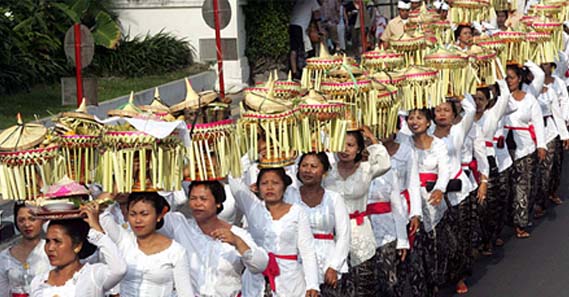pin up az
Holiday in Bali
Every 210 days the whole island of Bali sprouts flimsy bamboo poles, known as “penjor,” an unmistakable sign that Galungan fever is just about to kick in. Adorned with fruit, flowers and coconut leaves, these tall poles are found on every byway and highway and outside virtually every Balinese home, fluttering aimlessly in the breeze.

Galungan in Bali
Galungan is a unique 10 day celebration commemorating good over evil in typically melodramatic style. Balinese mythology is colorful to say the least and the story behind Galungan takes it to a whole new level. Briefly, it involves a shape-shifting evil giant, rivers of blood and a year-long battle royal between the Gods. During Galungan the Godly spirits return to earth and expect to be welcomed and entertained with important Balinese rituals and extravagant feasts.
From a visitor’s point of view, Galungan is second only for sheer spectacle to the Nyepi “Day of Silence”. Kuningan is the final day of the festival which brings proceedings to a close. It is all a much regimented occasion where every member of the household has specific tasks to perform and dressed in their “Sunday best” finery. The preceding days are all full of feverish activity – cooking, cleaning and making offerings. You’ll see the roads filled with convoys of scooters ferrying neatly dressed worshippers to and from temples carrying huge baskets of fruit, flowers or even live chickens.
The day before Galungan, men of the village head out at dawn in search of an unsuspecting pig which is to become the temple sacrifice. The meat is used to make traditional spicy “lawar” dishes containing satay, jackfruit, dozens of herbs and spices and always enough to feed a small army.
Only if you go native staying in a rural village or in a small family home stay do you see all the complicated preparations and hectic activity taking place behind the scene, although even in busy resorts such as Kuta, it’s virtually impossible to escape Kuningan fever.
There are road blocks erected outside main temples as waves of devotees flood the area, bringing even more maddening traffic chaos than usual. Many restaurants and shops close for a few days but this is not on the scale of Nyepi (when Bali becomes a ghost town). There is still no shortage of places to get a cold beer or two and a bite to eat.
On Galungan day itself (always the Wednesday) it’s a time for families; your favorite bartender or the girl who cleans your hotel room each morning will have headed off home to the ancestral village at dawn to spend time with the folks. After a full day of prayers, a few petty family quarrels and non stop eating, it’s back to relative normality with perhaps a family stroll into the paddy fields for a picnic. Villages throughout the island celebrate the post-Galungan period in their own peculiar way.
The streets of Ubud are flooded with schoolchildren performing “Barong” dances with great enthusiasm while further east in Klungkung, a number of villages indulge in frenzied “Jempana” war games complete with long bamboo sticks to the sound of relentless drumming. There is also the bizarre ritual of a village elder seemingly “stabbing” himself with a ceremonial dagger while in a trance-like state. Curious onlookers are always welcome at these occasions and in small off-the-beaten-path villages you are likely to become the center of attention, especially with the throng of giggling children.